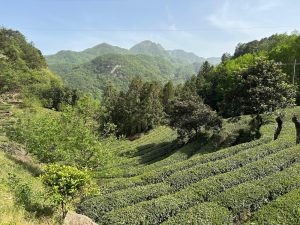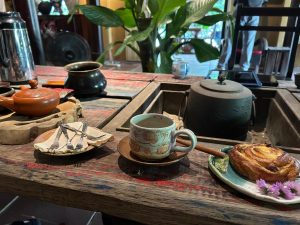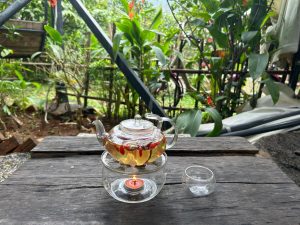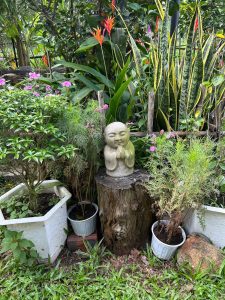Why mindfulness can feel out of reach
The art of mindfulness and meditation speaks to a way of being. Some people, especially those who find it difficult to sit still, may give up on meditation because of this. Also, if they are unable to simply close their eyes and thoughts become saturated with worries, finding a way to access an inner calm may feel out of reach. And when anxiety is heightened and internal noise takes over, trying to enter a meditative state can feel like adding pressure to an already overactive system.
When you’re wiped out, running on nervous energy, and just pushing through, something eventually gives and may lead to burnout. And anyone who’s been there knows, it’s not something you nap your way out of. The nervous system has shifted into survival mode and it needs repair and regulation.
A key to self-regulation is finding a practice that truly meets you where you are - one that grounds your experience through a sensory, tangible approach rather than something abstract. The mind may wander and travel into scary places, exacerbated by habitual negative thought patterns, as well as real-life circumstances. There are some things we don't have control over. However, we are placed in a far better position if we can find an inner space and centre from which to cope with whatever challenges are present.
So - how we respond and how we move toward wholeness - depends on our ability to be mentally, emotionally, and physically engaged in a meaningful way. This kind of presence can generate energy from within and increase our capacity to meet life with more resilience and clarity.
A gentle offering for mothers
As a therapist working closely with parents, I see the ripple effect that stress can have on the emotional climate of the entire family. When a mother is overwhelmed or depleted, it often shapes how a child feels, copes, and connects. With this in mind, I want to share something ancient, which is simple. Instead of spacing out, it helps to focus with intention through a mindful tea ritual. It induces a state of calm when fully engaged and also helps to ground you.
This gentle practice can offer a few quiet moments to release tension, become clearer and better placed to problem solve and enhance your own wellbeing and those you care for.
Mindfulness in motion
For many years, I’ve taught and practiced mindfulness with children, teens, and parents, in both individual sessions and group settings. I’ve long appreciated the calming qualities of herbal teas, but I hadn’t yet explored the deeper layers of tea as medicine - not just the ingredients, but as a full-body, sensory, and energetic experience.
What I’ve come to understand is that the healing power of tea lies not only in what’s brewed, but how it’s received; the posture of the body, the rhythm of the breath, the presence of intention. When tea is approached as a meditative ritual, it can raise our vibration, support our internal organs, and gently shift our mindset.
As I deepened this exploration, I met people who opened new doorways: a Chinese friend who grew up on a tea farm and shared childhood stories of harvesting and brewing; a quiet tea alchemist tucked away in the Son Tra mountains of Vietnam, blending herbs with presence and care. These encounters lit a spark in me.
But it was a recent trip to China that truly changed something. I spent a month in the Wudang Mountains, renowned for Daoist philosophy, traditional Chinese medicine, and martial arts. My initial intention was to immerse myself in Qigong, a meditative movement practice akin to Tai Chi. What I didn’t expect was to discover the way of tea as a spiritual and somatic experience. Each cup became a practice in presence, a medicine for body, breath, and mind.
Tea as meditation: a journey through ancient wisdom
Across different cultures, tea has offered a meditative doorway - a tangible quality to the practice of tea drinking through the senses. From the way we pour and hold the cup, to our posture and breath, each mindful sip creates space for energy to flow gently through the body. In these moments, inspiration can arise, problems may soften, and the spirit may be gently lifted.
Here are three brief glimpses into the roots of tea rituals in China, Japan, and Vietnam.

China is the birthplace of some of the oldest wild and cultivated tea trees, where the practice of tea drinking evolved through slow, mindful presence, to cultivate stillness, recognise the intricately woven essence of nature, and settle the spirit. Tea was also deeply embedded in the philosophy of Chinese herbal medicine, valued for its healing properties. It’s believed that tea trees originated in southwest China around 60 to 70 million years ago, and written records suggest that the ancestors began drinking tea over 3,000 years ago, as reflected in ancient texts and artworks.
In Japan, the tea ceremony evolved through the influence of Zen Buddhism. Every gesture, from the handling of the teacup to the quiet setting, reflects a deeper philosophy; to be fully present, to move with grace, and to create harmony between self, others, and the environment.

The origins of tea in Vietnam, as a cultural expression, stretch back over 2,000 years. Ceremonial tea drinking was infused with the philosophy of cultivating insight through mental clarity. A traditional Vietnamese tea experience places importance on the type of tea, the method of brewing, the aesthetics of the teapot and cup, and the presence of meaningful company.

The central themes that embody these meditative tea drinking practices reveal a common thread running through different cultures in the relaxation and savouring of each moment.
Creating a moment for you
The suggested ritual below is intended to enhance your self-care, like soft waves of gentle moments to reconnect with yourself. Allow it to deepen as you find pockets of time, whether you have five minutes or fifteen. This tea meditation offers you an inner and outer space to slow down, tune in, and receive the nourishment you need.
A simple tea ritual for mothers
When we hold a warm cup of tea with presence, we’re holding centuries of wisdom - an invitation to return to ourselves, to stillness, and to the quiet rhythm of nature.
Find a quiet space and a calming tea. You might wish to use a little bowl or Asian-style cup and a teapot you love. Give yourself 5-10 minutes of uninterrupted time. In the Daoist tradition, the essence of Wu Wei - effortless action - is centred on harmonising with nature, not pushing against it. Nature here means tuning in to the universal flow, sensing where things feel heavy or stuck, and where they move with ease.
Step 1: Prepare the Tea
- As you boil the water and choose your tea, bring awareness to each small gesture
- Notice your thoughts, your emotional landscape, and any tension in the body
- Begin to breathe slowly and deeply as you move through this simple process
- Place your teapot and cup in the space you've chosen for this moment
Step 2: Stillness
- Sit upright with a relaxed posture and spine straight
- Let your shoulders drop
- Lift your head gently as if it’s reaching toward the sky
- Feel your connection to the ground - perhaps imagine light beams connecting you to the earth’s core
- Place your hands on your belly and begin slow, natural breathing
- Allow your breath to settle into a gentle rhythm that is uniquely yours, attuned to the energy around you
Step 3: Engage the Senses
- Bring your tea pot and cup to the space you will be meditating
- Allow a couple of minutes for the tea to seep and strength its flavour
- Notice the steam as you gently pour a small amount of tea into the cup
- If you are using a small bowl, wrap your hands around the sides as you lift the bowl and feel its warmth and aroma of the tea and your hands around the sides like a womb
- If you are using a small Asian-style tea cup, hold it with one hand, and with the other place your hand on your belly or your heart, whichever feels intuitively resonant
Step 4: Sip Slowly
- Drink the tea slowly.
- With each sip, you may want to say aloud or silently "I am here. This moment is enough"
- As you continue, when the cup is empty, pour in more tea, stay in this energy field which you are creating
- Gaze into the cup filled with calming properties and imagine letting go of any stuck thoughts with each out-breath
- Let your gaze rest softly and say aloud or silently "Let the waters settle and the path will reveal itself"
Step 5: (Optional)
You may wish to ask yourself any of the following questions:
"What does clarity feel like in my body?"
"Where am I pushing and where am I flowing?"
"What would it look like to befriend the pace I'm in right now?"
"Instead of pushing or judging, what if this confusion or fatigue (add your own if you like) has wisdom that's trying to reach me?"
Step 6: Closing the Ritual-meditation
When you've finished, allow yourself to focus on gratitude. Gratitude is a way of getting in touch with a heartfelt moment that can have a positive rippling effect throughout your day.

Supporting you in the everyday
A tea ritual is just one small yet powerful way to bring more steadiness and calm into daily life. If you’d like to explore this further within your own parenting journey, I offer one-to-one sessions that integrate mindfulness, body-based awareness, and practical emotional support.
Since I work online, I support older children, adolescents, and young adults up to the age of 25. If you're a mother during pregnancy, with younger children or older, I also work with parents to build emotional resilience, nurture mindful connection, and navigate the challenges of parenting with greater steadiness and confidence.
Whether you're based in Southeast Asia or within a few hours of my time zone (currently Vietnam), you're welcome to reach out via my contact page to find out more or arrange a time to speak.

